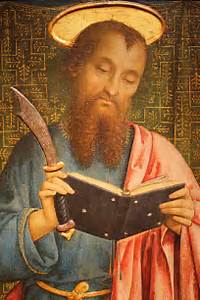
Saint Bartholomew is one of the twelve Apostles who hailed from Cana, Galilee. His name is mentioned sixth in the three Gospel lists (Matthew 10:3; Mark 3:18; Luke 6:14), and seventh in the list of Acts (1:13). The name Bartholomaios is the Greek form of Aramaic name which means son of Tolomai - a ploughman which is an ancient Hebrew name. In the New Testament, he is better known as Nathaniel (John 1:45-51, and 21:2) and referred to by many writers.
The Gospel passage read at feast day Mass is taken from John (1:45-51) where Nathaniel is introduced to Jesus by his friend Phillip, and Jesus says of him "Here is a true child of Israel. There is no duplicity in him (1:47)."
The Apostle's character is revealed in this concise and striking dialogue with the Lord Jesus. He is a good Jew, honest and innocent, a just man, who devotes much time to quiet reflection and prayer - "under the fig tree (1:48)" - and has been awaiting the Messiah, the Holy One.
Being a true child of Israel, Nathaniel was a man well-read in the Scriptures and knew what they said of the Messiah and where he would come from. This is why he is sceptical of Phillip's claim that Jesus is the Messiah: Can anything good come out of Nazareth (1:46)?
Nothing much is known about his life after the Ascension of Jesus, but tradition holds that he preached in the East. On the first Pentecost, after having received the gifts of the Holy Spirit, Bartholomew evangelized Iraq, Persia, Egypt, Turkey, northwestern India, and Greater Armenia in the first century. He died a martyr's death on August 24, in Armenia, being beheaded at Derbent in Azerbaijan (near Russia) on the Caspian Sea on the order of a local king for having converted a majority of the people there to Christianity.
His body was taken to the island of Lipari, north of Sicily, then to Benevento, and finally to Rome on an island in the Tiber where it is honoured by the faithful with pious devotion. Some of Bartholomew’s skin and bones are still kept in the Basilica of St Bartholomew in Rome, a part of his skull is in Frankfurt, Germany and an arm is venerated at the Canterbury Cathedral in England. In the famous scene of the Last Judgment in the Sistine Chapel in which Michelangelo painted St Bartholomew, who is holding his own skin in his left hand.
He is a patron of bookbinders, butchers, cobblers, Florentine cheese and salt merchants; leather workers, plasterers, shoemakers, tanners, trappers, twitching, whiteners. He is portrayed as a bearded man holding a book or a tanner's knife and human skin, or as a skinless man holding his own skin. He is invoked against nervous disorders and twitching.
Saint’s devotion in Goa
One of the traditions cites that Apostle Bartholomew arrived in India in 55 AD and spread the landed at Kallianpur on the banks of River Suvarna in Karnataka and went preaching through Goa to Kalyan in Maharashtra. In Goa, it is well-known that Christianity was already existent before the arrival of the Portuguese in 1510. The finding of a St Thomas cross with Pallavi inscription at Dandi, Agassaim is archaeological evidence to support this fact. According to the book ‘Äpostolic Christianity in Konkan,’ Apostle Bartholomew preached in Betalbatim and Chorão, before the arrival of the Portuguese.
He is a patron of Chorão village where his feast is celebrated with pomp and gaiety. The feast day also coincides with the harvest feast, possibly related to the farming traditions of the Saint. The church of St Bartholomew was built in the year 1569 by the Religious of the Society of Jesus and handed over to the Diocesan Clergy in 1597. The Chicalim church, which was founded in 1625 by the Jesuit society in Goa, was initially dedicated to St Bartholomew, however, it was later dedicated to St Francis Xavier.
Here is a short prayer to St Bartholomew. “Strengthen in us, O Lord, the faith, by which the blessed Apostle Bartholomew clung wholeheartedly to your Son, and grant that through the help of his prayers your Church may become for all the nations the sacrament of salvation. Through our Lord Jesus Christ, your Son, who lives and reigns with you in the unity of the Holy Spirit, God, forever and ever. Amen.”
(The writer is a teacher Grade I at R & P Salkar HSS of Arts and Commerce, Chorão, and a Catechist at St Michael church, Taleigão)